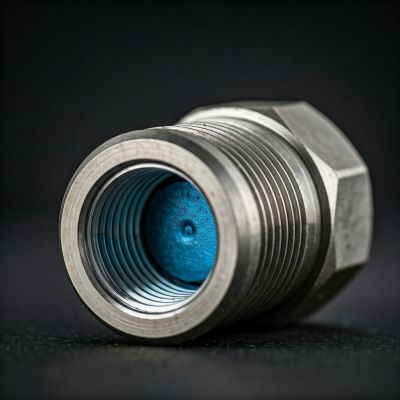Imagine you’re facing a mountain of hardware, each screw a unique puzzle. Frustration mounts as you grapple with mismatched threads, jeopardizing your entire project. Fear not!
This guide will equip you with the knowledge and skills to confidently identify UNEF threads, turning that mountain of hardware into a manageable and successful endeavor.
Introduction to UNEF Thread
What is UNEF Thread and Why is it Important?
UNEF (Unified National Extra Fine) threads are a type of screw thread with a finer pitch than the more common UNF (Unified National Fine) threads. This finer pitch offers several advantages, including:
➡️ Increased strength: The smaller distance between thread peaks allows for more material engagement, resulting in a stronger joint.
➡️ Improved sealing: The finer pitch can create a tighter seal, which is crucial in applications where leakage prevention is essential.
➡️ Enhanced precision: The smaller thread profile allows for more precise positioning and alignment of components.
Key Applications of UNEF Thread in Various Industries
UNEF threads find applications in a variety of industries, including:
➡️ Aerospace: Used in aircraft components where weight reduction and high strength are critical.
➡️ Automotive: Employed in high-performance engines and precision components.
➡️ Machining: Utilized in manufacturing processes that require tight tolerances and high accuracy.
➡️ Medical devices: Essential for the construction of implants and other critical components.
Understanding UNEF Thread Specifications
Definition and Structure of UNEF Thread
UNEF threads are defined by their:
➡️ Pitch: The distance between adjacent thread peaks.
➡️ Major diameter: The largest diameter of the thread.
➡️ Minor diameter: The smallest diameter of the thread.
➡️ Thread angle: The angle formed by the thread’s sides.
Common Dimensions and Tolerances Explained
UNEF threads are available in a wide range of sizes, each with specific dimensions and tolerances. These requirements are essential to guaranteeing a good fit and functionality.
UNEF Thread Standards: What You Need to Know
UNEF threads are standardized by organizations such as ANSI (American National Standards Institute) and ISO (International Organization for Standardization). 1 Adherence to these standards is essential for interchangeability and compatibility.
Tools and Techniques for UNEF Thread Identification
Essential Tools for Measuring Threads
Several tools are essential for accurately measuring thread parameters, including:
➡️ Thread pitch gauges: Used to measure the distance between thread peaks.
➡️ Micrometers: Used to measure the major and minor diameters of the thread.
➡️ Telescoping gauges: Used to measure the internal diameter of a threaded hole.
➡️ Thread calipers: Used to measure the effective diameter of the thread.
Step-by-Step Guide to Measuring UNEF Thread Pitch
1. Clean the thread: Remove any dirt or debris that may interfere with measurements.
2. Select the appropriate pitch gauge: Choose a gauge with teeth that match the thread pitch.
3. Engage the gauge: Place the gauge on the thread and rotate it until the teeth engage fully.
4. Read the pitch: The pitch is indicated on the gauge.
Identifying UNEF Thread vs. Other Thread Types
UNEF threads can be distinguished from other thread types by:
➡️ Finer pitch: UNEF threads have a smaller pitch than UNF threads.
➡️ Thread angle: The thread angle of UNEF threads is typically 60 degrees.
➡️ Thread profile: The thread profile of UNEF threads is more precise and defined.
Visual Cues to Recognize UNEF Thread
Examining the Thread Angle and Depth
By visually inspecting the thread, you can often determine its type. Look for:
➡️ Thread angle: Measure the angle between the thread flanks using an angle gauge or protractor.
➡️ Thread depth: Observe the depth of the thread grooves. UNEF threads typically have deeper grooves than UNF threads.
Recognizing UNEF Threads in Different Materials
The appearance of UNEF threads can vary depending on the material they are machined in. For example:
➡️ Metal: Metal threads typically have a sharp, well-defined profile.
➡️ Plastic: Plastic threads may have a slightly rounded profile due to the material’s properties.
Check out these other resources for your gain⬇️⬇️⬇️
How to Interpret NPT Thread Specification Like a Pro
A Beginner’s Guide to BSP Pipe Thread Standards
Common Challenges in Identifying UNEF Threads
Misidentification with Similar Threads
UNEF threads can be easily confused with other fine-pitch thread types, such as UNF and metric threads.
Troubleshooting Measurement Errors
Inaccurate measurements can lead to incorrect thread identification. Common sources of error include:
➡️ Tool wear: Worn-out measuring tools can produce inaccurate readings.
➡️ Improper technique: Incorrect use of measuring tools can lead to errors.
➡️ Environmental factors: Factors such as temperature and humidity can affect measurements.
Best Practices for Accurate UNEF Thread Identification
Tips for Using Thread Gauges Effectively
➡️ Ensure the gauge is clean and free of burrs.
➡️ Apply light pressure when engaging the gauge with the thread.
➡️ Rotate the gauge to ensure proper engagement.
How to Ensure Consistency in Identification
➡️ Use calibrated measuring tools.
➡️ Follow established procedures and guidelines.
➡️ Regularly check and calibrate measuring equipment.
Conclusion
Recap of Key Points for UNEF Thread Identification
➡️Understand the characteristics of UNEF threads, including pitch, diameter, and thread angle.
➡️ Use appropriate measuring tools and techniques.
➡️ Recognize possible error sources and take precautions to reduce them.
➡️ Follow best practices for accurate and consistent thread identification.
Why Proper Identification Matters for Quality and Safety
Accurate thread identification is crucial for:
➡️ Ensuring proper fit and function of components.
➡️ Preventing failures and malfunctions.
➡️ Maintaining the safety and reliability of equipment.
By following the guidelines outlined in this blog post, you can confidently identify UNEF threads and ensure the success of your projects.
Post time: Jan-02-2025


